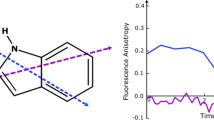Abstract
We measured fluorescence lifetimes of L-Tryptophan dissolved in de-ionized water and in ethanol in the absence and the presence of high progesterone concentrations. The hormone absorbs between 220 and 280 with a peak around 250 nm, while its absorption is equal to zero beyond 280 nm. Tryptophan excitation spectrum recorded in presence of progesterone shows that the So → 1La transition is completely abolished while the So → 1Lb transition is not affected. Emission of L-tryptophan in water occurs with two fluorescence lifetimes, 0.40 and 2.8 ns. In ethanol, three fluorescence lifetimes equal to around 0.2, 1.8 and 4.8 ns were observed. Addition of progesterone to the medium does not affect any of the fluorescence lifetimes indicating clearly that both transitions could induce tryptophan excitation and that recorded fluorescence lifetimes could be assigned to sub-structures generated in the excited state.
















Similar content being viewed by others
References
Ghanem M, Saen-oon S, Zhadin N, Wing C, Cahill SM, Schwartz SD, Callender R, Schramm VL (2008) Tryptophan-free human PNP reveals catalytic site interactions. Biochemistry 47:3202–3215. doi:10.1021/bi702491d
Maillard RA, Jordan M, Beasley DWC, Barrett ADT, Lee JC (2008) Long range communication in the envelope protein domain III and its effect on the resistance of west nile virus to antibody-mediated neutralization. J Biol Chem 283:613–622. doi:10.1074/jbc.M706031200
Albani JR, Carpentier M, Lansiaux C (2008) Fluorescence characterization of the hydrophobic pocket of cyclophilin B. J Fluoresc 18:75–85. doi:10.1007/s10895-007-0239-4
Ahnström J, Faber K, Axler O, Dahlbäck B (2007) Hydrophobic ligand binding properties of the human lipocalin apolipoprotein M. J Lipid Res 48:1754–1762. doi:10.1194/jlr.M700103-JLR200
Tayeh N, Rungassamy T, Albani JR (2009) Fluorescence spectral resolution of tryptophan residues in bovine and human serum albumins. J Pharm Biomed Anal 50:107-116
Lakowicz JR (1999) Principles of fluorescence spectroscopy. New York, Kluwer Academic/Plenum
Albani JR (2007) Principles and applications of fluorescence spectroscopy. Blackwell, London
Strickland EH, Billups C (1973) Oscillator strengthes of the 1 L a and 1 L b absorption bands of tryptophan and several other indoles. Biopolymers 12:1989–1995. doi:10.1002/bip.1973.360120906
Gudgin E, Lopez-Delgado R, Ware WR (1983) Photophysics of tryptophan in H2O, D2O and in non aqueous solvents. J Phys Chem 87:1559–1585. doi:10.1021/j100232a021
Petrich JW, Chang MC, McDonald DB, Fleming GR (1983) On the origin of nonexponential fluorescence decay in tryptophan and its derivatives. J Am Chem Soc 105:3824–3832. doi:10.1021/ja00350a014
Antonini PS, Hillen W, Ettner N, Hinrichs W, Fantucci P, Doglia SM, Bousquet JA, Chabbert M (1997) Role of Trp-187 in the annexin V-membrane interaction: a molecular mechanics analysis. Biophys J 72:1800–1811. doi:10.1016/S0006-3495(97)78826-X
Kuszaj S, Kaszycki P, Wasylewski Z (1996) Fluorescence and phosphorescence study of Tet Repressor–Operator interaction. J Protein Chem 15:607–619. doi:10.1007/BF01886743
Martinho JMG, Santos AM, Fedorov A, Baptista RP, Taipa MA, Cabral JMS (2003) Fluorescence of the single tryptophan of cutinase: temperature and ph effect on protein conformation and dynamics. Photochem Photobiol 78:15–22. doi:10.1562/0031-8655(2003)078<0015:FOTSTO>2.0.CO;2
Albani JR (2007) New insights in the interpretation of tryptophan fluorescence. Origin of the fluorescence lifetime and characterization of a new fluorescence parameter in proteins: the emission to excitation ratio. J Fluoresc 17:406-417
Broos J, Tveen-Jensen K, de Waal E, Hesp BH, Jackson JB, Canters GW, Callis PR (2007) The emitting state of tryptophan in proteins with highly blue-shifted fluorescence. Angew Chem Int Ed. 46:5137–5139. doi:10.1002/anie.200700839
Valeur B, Weber G (1977) Resolution of the fluorescence excitation spectrum of indole into the 1La and 1Lb excitation bands. Photochem Photobiol 25:441–444. doi:10.1111/j.1751-1097.1977.tb09168.x
Grinvald A, Schlessinger J, Pecht I, Steiberg IZ (1975) Homogeneity and variability in the structure of azurin molecules studied by fluorescence decay and circular polarization. Biochemistry 14:1921–1929. doi:10.1021/bi00680a018
Albani, JR (2009) Fluorescence origin of 6,p-toluidinyl-naphthalene-2-sulfonate (TNS) bound to proteins. J Fluoresc 19:399–408
Author information
Authors and Affiliations
Corresponding author
Rights and permissions
About this article
Cite this article
René Albani, J. Fluorescence Lifetimes of Tryptophan: Structural Origin and Relation with So → 1Lb and So → 1La Transitions. J Fluoresc 19, 1061–1071 (2009). https://doi.org/10.1007/s10895-009-0506-7
Received:
Accepted:
Published:
Issue Date:
DOI: https://doi.org/10.1007/s10895-009-0506-7




